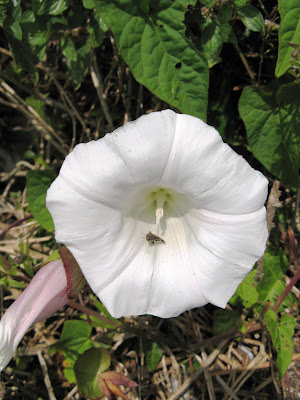



























 Visited in Loughor by a Brimstone moth (Opisthograptis luteolata) and saw a ground beetle (Pterostrichus nigrita) behind the canoe. In Bynea, Biting stonecrop (Sedum acre) and Spring cinquefoil (Potentilla tabernaemontani) were in flower. In Penclacwydd, Arctic sandwort (Arenaria norvegica), Common fumitory (Fumaria officinalis) and Bithynian vetch (Vicia bithynica) were in bloom and Bittersweet (Solanum dulcamara) had developed its green berries. On a hot day in Horton, saw Large-flowered evening primrose (Oenothera erythrosepala), Pyramidal orchid (Anacamptis pyramidalis), Sweet allison (Lobularia maritima), Field bindweed (Convolvulus arvensis), Great bindweed (Calystegia sylvatica), Stinking iris (Iris foetidissima), Tree mallow (Lavatera arborea), Golden samphire (Inula crithmoides), the parasitic Common broomrape (Orobanche minor), Pink oxalis (Oxalis articulata), Rest-harrow (Ononis repens) and Navelwort (Umbilicus rupestris) all in flower. They were visited by a Small tortoiseshell butterfly (Aglais urticae) with one antenna, a male Oedemera nobilis beetle and a tiny green beetle. The local Burnet rose (Rosa pimpinellifolia) was infested by a bright orange rust. A sunken clay beach was revealed with vegetation as well as much much earlier fossils in the rocks. An impressively large Sea slater (Ligia sp) scuttled on these structures.
Visited in Loughor by a Brimstone moth (Opisthograptis luteolata) and saw a ground beetle (Pterostrichus nigrita) behind the canoe. In Bynea, Biting stonecrop (Sedum acre) and Spring cinquefoil (Potentilla tabernaemontani) were in flower. In Penclacwydd, Arctic sandwort (Arenaria norvegica), Common fumitory (Fumaria officinalis) and Bithynian vetch (Vicia bithynica) were in bloom and Bittersweet (Solanum dulcamara) had developed its green berries. On a hot day in Horton, saw Large-flowered evening primrose (Oenothera erythrosepala), Pyramidal orchid (Anacamptis pyramidalis), Sweet allison (Lobularia maritima), Field bindweed (Convolvulus arvensis), Great bindweed (Calystegia sylvatica), Stinking iris (Iris foetidissima), Tree mallow (Lavatera arborea), Golden samphire (Inula crithmoides), the parasitic Common broomrape (Orobanche minor), Pink oxalis (Oxalis articulata), Rest-harrow (Ononis repens) and Navelwort (Umbilicus rupestris) all in flower. They were visited by a Small tortoiseshell butterfly (Aglais urticae) with one antenna, a male Oedemera nobilis beetle and a tiny green beetle. The local Burnet rose (Rosa pimpinellifolia) was infested by a bright orange rust. A sunken clay beach was revealed with vegetation as well as much much earlier fossils in the rocks. An impressively large Sea slater (Ligia sp) scuttled on these structures.
%20mating%20NWCW.jpg)


No comments:
Post a Comment